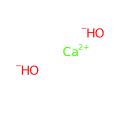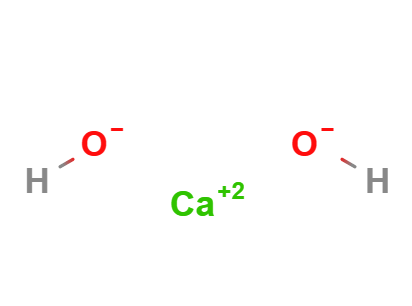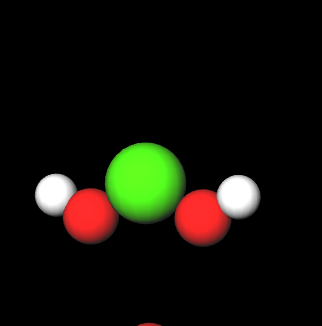| "Descrizione" by Frank123 (12058 pt) | 2024-May-14 09:20 |
Review Consensus: 9 Rating: 9 Number of users: 1
| Evaluation | N. Experts | Evaluation | N. Experts |
|---|---|---|---|
| 1 | 6 | ||
| 2 | 7 | ||
| 3 | 8 | ||
| 4 | 9 | ||
| 5 | 10 |
Calcium hydroxide is a chemical compound obtained by a calcination process of calcium carbonate.
The name defines the structure of the molecule:
- "Calcium" is a chemical element with symbol Ca and atomic number 20. It is an alkaline-earthy metal of pale grey colour and is the fifth most abundant element in mass in the earth’s crust. It is an alkaline-earthy metal of a pale gray color and is the fifth most abundant element by mass in the Earth’s crust.
- "hydroxide" is a biatomic anion with the chemical formula OH-. It consists of an oxygen atom and a hydrogen atom held together by a covalent bond and has a negative electric charge.
The synthesis process takes place in several stages:
- Raw material: Calcium is obtained from limestone, which contains calcium carbonate, calcium sulfate and other minerals.
- Extraction: Calcium is extracted from limestone by heating it to a high temperature, above 825 degrees Celsius, resulting in the production of quicklime (calcium oxide) and carbon dioxide.
- Hydration: Quicklime is then mixed with water in a process known as slaking, which leads to the formation of calcium hydroxide.
- Purification: Calcium hydroxide is then purified by removing the remaining quicklime and other impurities. This is usually done by adding more water to the mixture, which causes the impurities to float high up, where they can be easily removed.
- Drying: The purified calcium hydroxide is then dried to remove the remaining water, resulting in a fine white powder.
- Packaging: Calcium hydroxide is then packaged and stored for use in various applications, such as in the construction industry, where it is used as a key ingredient in mortars and plasters.
The compound "calcium hydroxide" is a colorless crystal or a white powder and is obtained when calcium oxide (called lime or quicklime) is mixed or skimmed with water. It has many names, including hydrated lime, caustic lime, construction lime, quicklime, cal, or pickling lime.

What it is used for and where
Food
An ingredient listed in the European food additives list as E526, it acts as an acidity regulator and reacts with organic acids. It also acts as a thickener and hardener.
Medical
Dentistry. It is an antimicrobial that acts on dentin, apical barrier and dental lesions effectively (1), but may be ineffective against some bacterial species present in root canal infections. Anti-endotoxin agent.
Cosmetics
Buffering agent. It is an iingredient that can bring an alkaline or acid solution to a certain pH level and prevent it from changing, in practice a pH stabiliser that can effectively resist instability and pH change.
Safety
It is a restricted ingredient III/15c as a Relevant Item in the Annexes of the European Cosmetics Regulation 1223/2009. Entries 15b and 15c stipulate the restrictions and conditions of use concerning Lithium hydroxide and Calcium hydroxide respectively. The entries include the mention 'Other uses' without indication on limitations or requirements for use. The European Cosmetic Toiletry and Perfumery Association - the SCCNFP adopts the attached proposal to extend entries 15b and 15c by the addition of a text in the column 'field of application', in the column 'maximum authorised concentration' and in the column 'conditions of use and warning to be labelled' (1).
Wording of conditions of use and warnings
a) Hair straighteners containing two components: calcium hydroxide and a guanidine salt. 7% (as calcium hydroxide)
- Contains alkali
- Avoid contact with eyes
- Keep out of reach of children
- Can cause blindness
(b) pH ajuster for depilatories pH < 12.7
- Contains alkali
- Keep out of reach of children
- Avoid contact with eyes
(c) Other uses (e.g. pH adjuster, processing aid) pH < 11
Other uses
- Decarbonisation and softening techniques in water stabilisation and treatment processes.
Safety
It is a strong alkaline agent and can cause injury to epidermal tissues at certain concentrations.
 |  |
 |
- Molecular Formula CaH2O2 Ca(OH)2
- Molecular Weight 74.09
- CAS 1305-62-0
- UNII PF5DZW74VN
- EC Number 215-137-3
References_____________________________________________________________________
(1) Estrela, C. and Holland, R., 2003. Calcium hydroxide: study based on scientific evidences. Journal of Applied Oral Science, 11, pp.269-282.
Abstract. The characteristics of calcium hydroxide come from its dissociation into calcium and hydroxyl ions. The action of these ions on tissues and bacteria explains the biological and antimicrobial properties of this substance. Under the conditions of this retrospective of literature, based on scientific evidences, it is possible to state that: 1. Dentin is considered the best pulpal protective, and calcium hydroxide has proved, through numerous studies, its capability of inducing the formation of a mineralized bridge over pulpal tissue. 2. It is necessary, whenever possible, to provide time for calcium hydroxide paste to manifest its potential of action on the microorganisms present in endodontic infections. The maintenance of a high concentration of hydroxyl ions can change bacteria enzymatic activity and promote its inactivation. 3. The site of action of hydroxyl ions of calcium hydroxide includes the enzymes in the cytoplasmic membrane. This medication has a large scope of action, and therefore is effective on a wide range of microorganisms, regardless their metabolic capability. In microbial world, cytoplasmic membranes are similar, irrespective from microorganisms morphological, tinctorial and respiratory characteristics, which means that this medication has a similar effect on aerobic, anaerobic, Gram-positive and Gram-negative bacteria. 4. Calcium hydroxide as temporary dressing used between appointments promotes better results on the periapical healing process than the treatment in one appointment.
| Evaluate |

